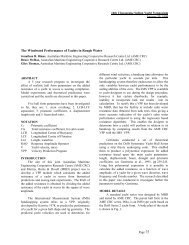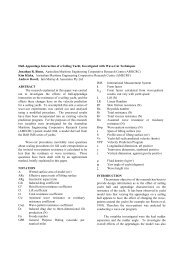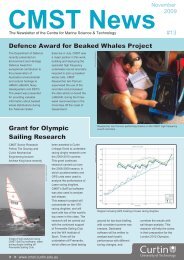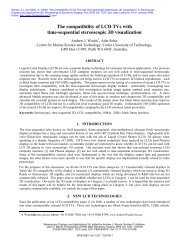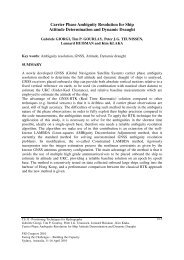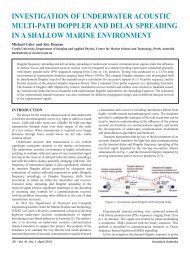Blue whale calling in the Rottnest trench-2000, Western ... - ANP
Blue whale calling in the Rottnest trench-2000, Western ... - ANP
Blue whale calling in the Rottnest trench-2000, Western ... - ANP
Create successful ePaper yourself
Turn your PDF publications into a flip-book with our unique Google optimized e-Paper software.
16:00) us<strong>in</strong>g comb<strong>in</strong>ations of mean callers/block for night/next-day and night/previous day. It<br />
can also be seen from Figure 41 that <strong>the</strong> 20 Hz click<strong>in</strong>g was prevalent, often at very high<br />
received levels (near to amplifier saturation) up to 153 dB re 1μPa peak-peak. Shipp<strong>in</strong>g noise<br />
was present <strong>in</strong> 27% of <strong>the</strong> samples of which 14% were qualitatively recorded as 'high' level and<br />
<strong>the</strong> rema<strong>in</strong><strong>in</strong>g 64% at low or <strong>in</strong>termediate levels (based on visual comparison of spectrogram<br />
<strong>in</strong>tensity only).<br />
Table 4: Details of record<strong>in</strong>gs made and presence of blue <strong>whale</strong> <strong>call<strong>in</strong>g</strong>. Abbreviations or superscripts are: 1 - f<strong>in</strong>ish<br />
date given only for sets with repetitive sampl<strong>in</strong>g as opposed to a s<strong>in</strong>gle drift sample (see Table 1); 2 - for sets 2459<br />
and 2466 times are start time of first and last sample respectively; C, M, D - close, medium, distant, respectively.<br />
Set # date<br />
start<br />
f<strong>in</strong>ish 1<br />
useable<br />
time<br />
start /<br />
stop 2<br />
2456 10-Jan 09:20-<br />
10:58<br />
2459 10-Jan 12:08-<br />
12-Jan 09:56<br />
2460 13-Jan 09:56-<br />
13:15<br />
2461 18-Jan 09:17-<br />
13:26<br />
2462 28-Jan 08:38-<br />
12:49<br />
2463 29-Jan 09:21-<br />
13:25<br />
2464 12-Feb 13:27-<br />
16:05<br />
2465 14-Feb 08:26-<br />
11:55<br />
2467 17-Feb 08:23-<br />
09:00<br />
2468 27-Feb 09:12-<br />
12:38<br />
2469 28-Feb 09:34-<br />
13:45<br />
2466 8-Mar 00:10 -<br />
10-Apr 12:30<br />
2470 13-Mar 12:20-<br />
13:00<br />
blue<br />
<strong>whale</strong><br />
calls<br />
# blue<br />
<strong>whale</strong><br />
callers<br />
airguns<br />
39<br />
Notes<br />
N 0 ship passage at 3-4 n mile range<br />
Y- D 1-2 distant blue <strong>whale</strong> <strong>call<strong>in</strong>g</strong> only, moderate flow noise<br />
N 0 high flow noise throughout<br />
Y - D 1 Y distant blue <strong>whale</strong> <strong>call<strong>in</strong>g</strong> only, fa<strong>in</strong>t air-gun signals<br />
Y - C 1-2 Y 1-2 blue <strong>whale</strong> callers, one relatively short range, several large<br />
breaks <strong>in</strong> <strong>call<strong>in</strong>g</strong>, air-gun signals <strong>in</strong>crease towards end of tape,<br />
believed <strong>call<strong>in</strong>g</strong> from Rissos dolph<strong>in</strong>s heard<br />
Y - D 1 Only few calls of s<strong>in</strong>gle distant blue <strong>whale</strong> evident, much flow<br />
noise, distant air-gun signals<br />
Y - D 1 Y S<strong>in</strong>gle blue <strong>whale</strong> fades <strong>in</strong> and out at maximum range, distant<br />
air guns sometimes evident, moderate flow noise<br />
Y - D 1-2 Y Two blue <strong>whale</strong>s at range, very fa<strong>in</strong>t air-gun signals<br />
Y - M 1-3 N Whole section contam<strong>in</strong>ated with nearby shipp<strong>in</strong>g noise,<br />
difficult to recognise blue <strong>whale</strong> calls although three evident at<br />
one po<strong>in</strong>t<br />
Y - M 1-4 Y - F One to four separate blue <strong>whale</strong>s, ship passage and high flow<br />
noise make much of record difficult to discern callers<br />
Y - 1-9 Large amounts blue <strong>whale</strong> <strong>call<strong>in</strong>g</strong> and 20 Hz 'clicks' over 5<br />
C/D<br />
weeks of deployment, some air-gun signals<br />
N 0 N No blue <strong>whale</strong> <strong>call<strong>in</strong>g</strong>, no air-gun signals<br />
The automatic call count<strong>in</strong>g technique (section 3.7) was <strong>the</strong>n run over <strong>the</strong> 4827 records. The<br />
result<strong>in</strong>g count of <strong>the</strong> mean number of callers (averaged <strong>in</strong> six hour blocks with 95% error bars<br />
shown) for <strong>the</strong> entire deployment (8th March to 10th April) is shown on Figure 43 along with <strong>the</strong><br />
sight<strong>in</strong>g data for overlapp<strong>in</strong>g boat surveys. This analysis returned <strong>call<strong>in</strong>g</strong> statistics for <strong>the</strong> 4827 x<br />
90 s blocks over <strong>the</strong> 33 days of deployment of:<br />
• m<strong>in</strong>imum number of <strong>call<strong>in</strong>g</strong> blue <strong>whale</strong>s of zero / 90 s block<br />
• maximum number of <strong>call<strong>in</strong>g</strong> blue <strong>whale</strong>s at eight / 90 s block<br />
• mean number of callers per 90 s block of 1.02 ± 0.03 (95% confidence limits)<br />
• mean number daytime callers per 90 s block of 0.74 ± 0.16<br />
• mean number of night time callers per 90 s block of 1.06 ± 0.18



